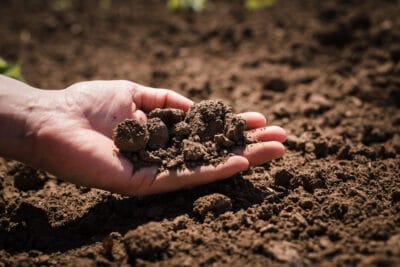
As last week marked World Soil Day, one of the UK Agri-Tech Centre’s resident experts is keen to share his knowledge on the subject.
In this blog, Dr Harry Langford, Head of Sustainability at the UK Agri-Tech Centre, highlights the vital role of soil health in UK agriculture and explores how combining systems thinking with innovative technology can promote soil-smart practices that ensure long-term sustainability.
Soil is often called the foundation of life, and for good reason: it supports 95% of the world’s food production and stores vast amounts of carbon, making it critical for combatting climate change.
The Importance of Healthy Soils
Soil health refers to the ability of soil to function as a living ecosystem that sustains plants, animals, and humans. Yet, this invaluable resource faces multiple threats. Since 1978, the UK has seen an 11% decline in soil carbon from cropland, reducing the capacity to sequester carbon and support crop productivity. Globally, soils are being lost to erosion and degradation at rates 10 times faster than they are being formed. Despite this, soil protection has historically been overlooked, with frameworks like the UK Agricultural Bill only recently recognising soil as a public good.
Healthy soils are essential for mitigating climate impacts, as they buffer against temperature extremes and regulate water availability. They also hold immense potential for carbon sequestration, with UK soils storing approximately 10 billion tonnes of carbon. Yet, emissions from land use contribute significantly to the UK’s greenhouse gas output, creating a major barrier to achieving net-zero commitments under the Paris Agreement.
A Systems Approach to Soil Health
To tackle soil degradation effectively, we must adopt a systems approach that considers soil biology, chemistry, and structure as interconnected elements.
Soil Structure: Well-aggregated soils resist compaction and waterlogging, improving root growth and nutrient uptake. Techniques like no-till farming and controlled traffic systems enhance soil porosity and water regulation.
Soil Organic Matter (SOM): SOM is the cornerstone of soil fertility, contributing to nutrient cycling, water retention, and carbon sequestration. Its stability depends on interactions with soil minerals and microbial activity, as well as being related to clay content. Practices like incorporating compost, using cover crops, and reducing tillage enhance SOM levels, improving soil resilience to erosion and climate variability.
Soil Chemistry: Balanced soil chemistry ensures optimal nutrient availability and pH. Low pH (<6) risks aluminum toxicity, while excess phosphorus can suppress mycorrhizal fungi, for example. Sustainable practices like soil testing, precise nutrient application, and integrating legumes help maintain balance, enhancing soil and crop health.
Soil Biology: A teaspoon of soil may contain up to 10 billion microorganisms. Within this biome, decomposers and mineralisers are vital for organic matter cycling and nutrient availability. Practices like crop rotation, cover cropping, and integrating livestock can boost biodiversity and promote healthy microbial ecosystems.
This integrated perspective ensures that soil management decisions deliver benefits across both environmental and economic dimensions, critical when farmers are both custodians of the soil and food producers.
Combining Technology and Practice for Soil-Smart Agriculture
While sustainable practices lay the groundwork, technology can amplify their impact. Innovations in soil monitoring and mapping provide farmers with data-driven insights to optimise soil health, whilst novel amendments build soil health and carbon sequestration.
Precision Soil Management: Novel sensor technologies like SoilOptix, electronic nose sensors like PES Technologies, and precision soil mapping services like RHIZA can accurately assess soil properties such as organic matter, nutrient profiles, and moisture. These technologies enable the precision application of nutrients, ensuring efficient resource use.
Biological Innovations: Microbial biomass analyses are enhancing our understanding of soil biology, complementing traditional analyses and eventually enabling a more bespoke approach to organic and microbial amendment. Several UK innovators including Plant Works have developed microbial soil enhancers, such as those derived from arbuscular mycorrhizal fungi (AMF), which enhance nutrient cycling and plant resilience by improving nutrient scavenging.
Novel Amendments: Organic matter additions, such as biochar or compost, can restore degraded soils, improve their water-holding capacity, and add organic carbon, supporting sequestration when conditions allow. UK SMEs like Woodland Grow and Soil Ecology Laboratory are pioneering more bio-complete inoculants. Rock powders, particularly basalt, can consume carbon dioxide from the air as they weather, as well as releasing silicate nutrients. Companies like UNDO are pioneering this across the UK.
By combining these technologies with established sustainable and regenerative practices, such as no-till systems and cover cropping, farmers can accelerate soil restoration while improving productivity.
Engineering Soils for Regenerative Agriculture
The health of the UK’s soils is both a critical challenge and a tremendous opportunity. One challenge facing UK farmers is how to most effectively build soil health. Transitioning to regenerative practices like no-till or cover cropping often requires upfront investment with delayed returns, whilst soil health improves.
I like to take an engineering perspective on this challenge. Whilst it took over 50 years to breed plants for the demands of modern agriculture, we now face the task of engineering soils for regenerative agriculture, but ideally within a decade. Thankfully, nature can help us with this engineering. I visualise soil engineering as being across two complementary phases: priming and optimising.
Priming involves longer-term, iterative approaches aimed at fundamentally improving soil health while optimising focuses on shorter-term, reactive interventions to address immediate issues. Both can be achieved by combining technology and practice, but the balance between the two depends heavily on the cropping system and economic circumstances.
For instance, high-value vegetable crops may justify significant investment in optimisation, while perennial crops such as orchards might benefit more from long-term priming strategies. By adopting a strategic blend of these approaches, I believe that UK farmers can accelerate their soil health transition.
So, reflecting on this year’s World Soil Day, let’s commit to soil-smart agriculture because the health of our soils is the health of our future.













